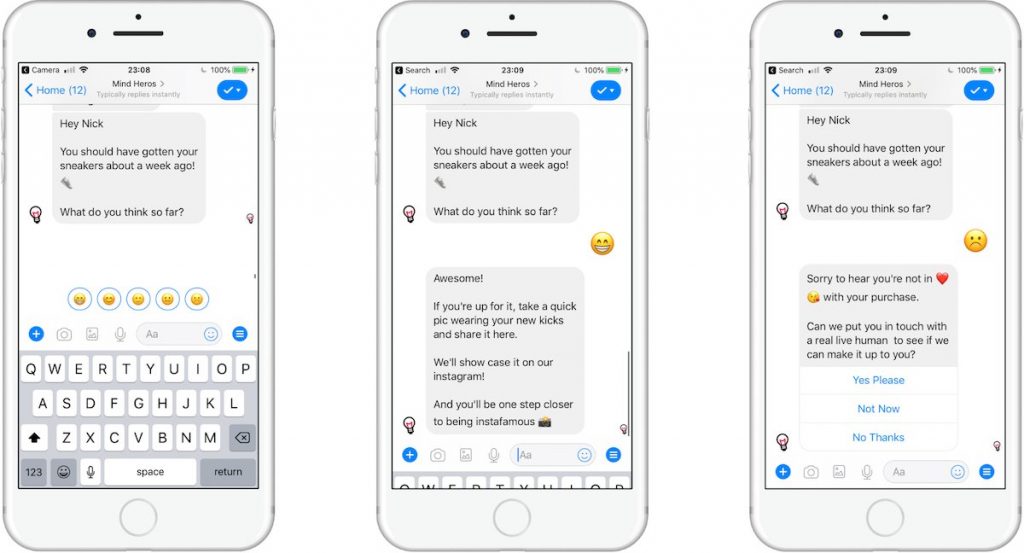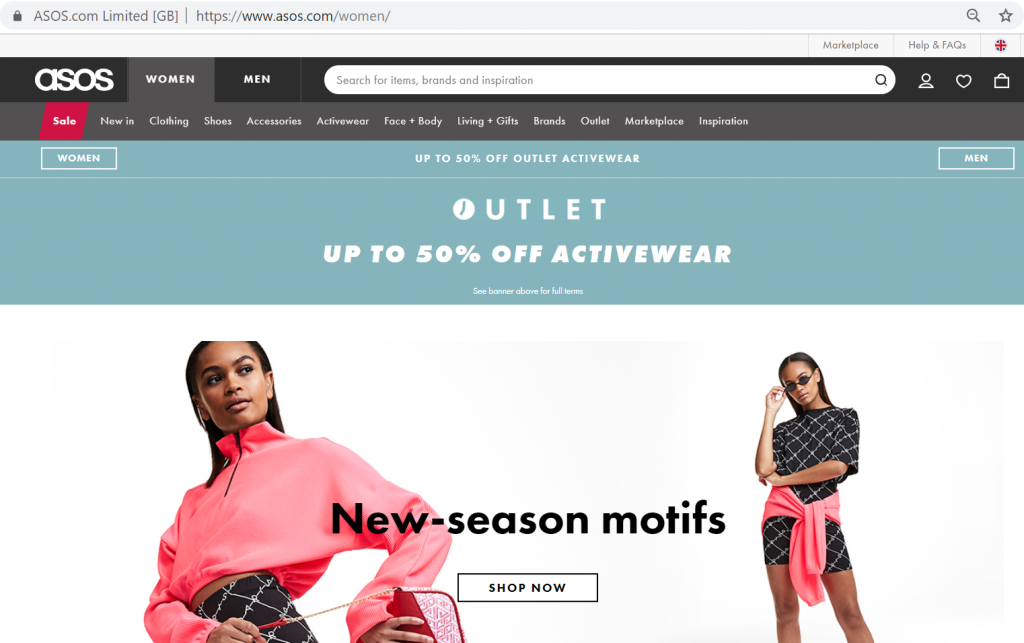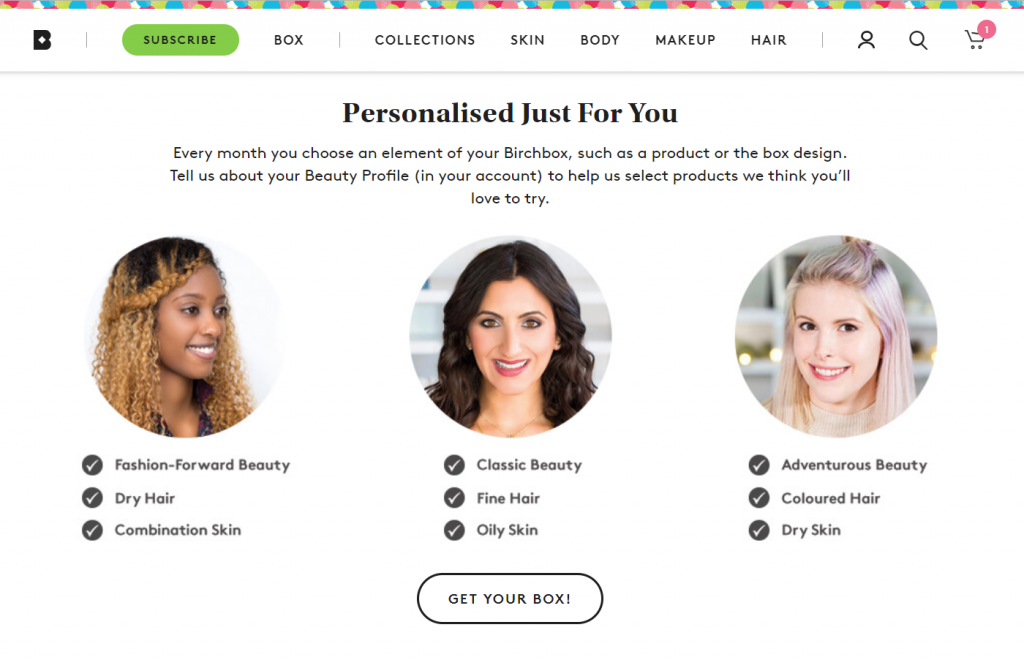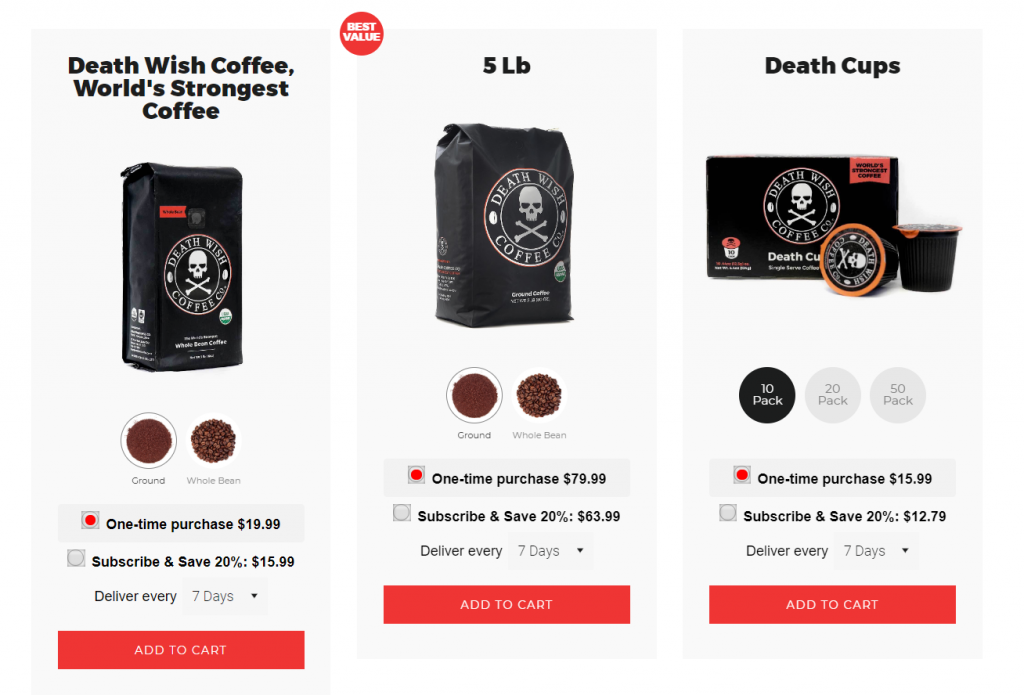Latest Ecommerce Trends (2019)
The ecommerce industry is thriving. In fact, worldwide retail ecommerce sales are predicted to reach a staggering $4.8 trillion in 2021! That’s more than 260% growth in just five years.
As this booming industry grows, it is constantly evolving. Advancements in technology and changes in consumer behaviour influence the ever-changing landscape of ecommerce, presenting merchants with innovative and exciting ways to drive their ecommerce stores forwards.
Written By
Hannah Smiddy

In such a fast-growing, dynamic industry, it’s important to stay one step ahead of the latest trends. With knowledge of what’s hot and what’s not in the world of ecommerce, you can position your brand as a leader in its field.
Here is our round-up of some of the biggest ecommerce trends to embrace in 2019 …
#1 Augmented Reality (AR)
AR is a technology that integrates computer-generated models with a user’s existing environment. This exciting advancement is expected to totally transform the ecommerce industry this year. It will improve the online shopping experience, bridging the gap between traditional brick-and-mortar stores and ecommerce sites. AR is set to be a game-changing trend in 2019 for brands specialising in homewares, fashion and beauty in particular.
How can AR benefit your ecommerce store?
When shopping on the high street, consumers can physically experience a product. They can touch it, pick it up and try it on. As an online retailer, it’s essential to provide consumers with a strong visual representation of your products in order to make up for this lack of physical interaction.
AR helps achieve exactly this. It gives shoppers a new way to experience products from the comfort of their laptop or smartphone. AR brings products to life. Customers can get a truer sense of an item’s size, scale and unique details. They can place 3D product models in the environment around them, allowing them to experience wearing, using or living with products.
Swedish furniture giant IKEA are leading the way with AR-guided shopping. They want to harness this advanced technology to change the way people buy furniture forever. The IKEA Place app enables consumers to virtually place furniture in their own environment. It allows consumers to make more informed decisions when considering whether or not a product is right for them and their home.
This richer buying experience helps to engage shoppers, which in turn increases buying confidence. For merchants, this means higher conversion rates, increased sales revenue and fewer returns.
Shopify AR
Last year, Shopify made AR-guided shopping a reality for ecommerce customers with its 3D Warehouse app. In a bid to unlock the huge business potential of AR, Shopify built a services marketplace to help merchants create 3D models of their products. These models are viewable in AR directly through the Safari browser on iOS 12 devices, thanks to Apple’s AR Quick Look.
Ecommerce AR in action
Global bicycle brand Pure Cycles have been using Shopify’s 3D Warehouse app to create models of their products. They are hugely excited about the potential to provide their customers with an immersive, empowering shopping experience where they can remotely explore every inch of a product. For Pure Cycles, AR will help customers overcome conversion obstacles which traditionally hinder checkouts.
Demonstration of Pure Cycle’s AR-guided shopping. (Source: Shopify)
“Being able to see how it looks in your living room or your garage, wherever you keep it, I think, is a major benefit. That, and the fact that it is a very sleek-looking bike, so having the AR model really helps sell the future, high-tech feeling of the product.”
Jordan Schau, Co-Founder of Pure Cycles
#2 Chatbots
Chatbots are transforming the way that brands interact with their customers through advanced machine learning. This is a trend that will only continue to grow in 2019. By next year, it’s predicted that chatbots will be tackling a huge 85% of customer service interactions. Alas, now is a great time to think about utilising chatbots for your ecommerce brand.
But what exactly is a chatbot? Simply put, it is a piece of software that can converse with humans via a live chat interface. The conversation can take place on an ecommerce site or through platforms like Facebook Messenger and WhatsApp. Chatbots compare the input from the user with a huge database and then return the most suitable solution. More sophisticated chatbots, which are powered by artificial intelligence, can use natural language to create more complex conversations.
Currently, the majority of chatbots support customers with product questions and complaints. They have the potential to add much more to an online shopping experience though. As an ecommerce manager, you can use a chatbot to drive acquisition, retention and loyalty.
Drive acquisition
Firstly, bots can reduce friction when capturing and engaging with leads. For instance, Shopify or Shopify Plus merchants can use Facebook’s native Messenger integration to display a chat bubble universally across their site. This allows users to interact with a brand via their Messenger account from every store page. Merchants can also link Facebook ads with Messenger chatbots, which is perfect for streamlining subscription processes. With just one click of a button, users engage in Messenger and you have access to their name, gender, preferred language and many other details (all GDPR aligned, of course).
 Example showing a Messenger chat bubble integrated with a product page. (Source: Shopify)
Example showing a Messenger chat bubble integrated with a product page. (Source: Shopify)
Incentivise first-time sales
Offering discounts inside a chatbot presents a range of opportunities for merchants. For example, you can direct prospects from coupon landing pages to chatbots to seamlessly capture customer information. Your bots can then offer a discount code, and encourage engagement with the customer through personalised messages. For your users, this simple method of receiving a discount code offers instant gratification. And, if the coupon remains unused, bots can even follow-up with the customer.
Facilitate customer retention
Chatbots are a great way to provide customers with a ‘VIP experience’. They offer personalised interaction and special offers from the get-go, which satisfies consumers’ increasing need for customised experiences. Furthermore, your customers can use chatbots across devices, which provides a seamless shopping experience.
The use of chatbots to provide fun and engaging quizzes is becoming increasingly popular too. Based on the quiz responses given, the chabot can better serve the customer by delivering personalised content and messaging.
Increase conversions
There are a number of ways in which chatbots can drive conversions. They can achieve hyper-personalisation by combining the different types of interactions they have with customers with trackable actions. Expect to see chatbots increasing conversions and creating a smoother purchasing journey by proactively reaching out to the customers on ecommerce sites to offer additional product information and purchase suggestions.
A huge barrier to conversion is cart abandonment. This year, we are likely to see more and more ecommerce brands using chatbots to counter this. One study of 547 abandoned carts showed that reminders sent by a Messenger bot recovered 13-20% of lost orders. This is more than those saved by emails.
Increasingly, consumers expect an immediate response to any questions or concerns they have about a product. As a busy ecommerce manager, it can be extremely difficult to keep up with the rate of queries coming in. This is especially true in peak trading periods. Your human support staff need sleep too, so customers sometimes have to wait until the next business hours for support. Thankfully, this is where chatbots come in. Always in operation, they act as 24/7 personal shoppers for each user on your store. They can provide the instant response customers are looking for. This helps to prevent customer frustrations and resulting cart abandonment.
Retain and engage existing customers
Chatbots can continue the conversation with customers beyond their order being placed, offering multiple post-sales opportunities. You may choose to send a post-purchase ‘check-in’ shortly after a customer’s item has been delivered. This might include an opportunity for them to review their new product. Depending on the outcome of the review, it can either be automatically posted on social media, shared with friends or followed up in a proactive customer service flow.

Examples of how Messenger bots can be used to follow up with customers post-purchase. (Source: Shopify)
Merchants are increasingly using bots to send personalised replenishment emails in accordance with product consumption cycles. This is also a clever way of presenting customers with an optional subscription.
What’s more, chatbots can be used to engage customers in loyalty programs. They can be programmed to automate point balance updates, encourage point redemption and provide reward reminders.
#3 Voice search
Did you know that over 20% of search queries are made via voice? By 2020, this is set to rise to half of all internet searches. This new way of searching and interacting with devices represents a valuable opportunity for ecommerce merchants in 2019. It shows that customers are making more and more purchases from voice-activated assistants like Amazon’s Alexa, Apple’s Siri and Google Home – a trend to take advantage of.
Complex voice searches can also provide a useful insight into the searcher’s intent, as well as their point in the purchasing journey. This provides the potential for valuable, relevant engagement with customers.
Optimise your store for voice searches
More and more ecommerce brands are likely to embrace this trend to continue attracting and engaging customers in what is an increasingly competitive retail world. To really use this voice search trend to your business’ advantage, it’s important to know how to effectively target voice queries and deliver the information your customers are seeking.
Firstly, you need to consider how voice search could impact search engine optimisation, or SEO. Voice searches are likely to be longer and more complex than traditional written queries on a search engine. Therefore, brands wanting to fully benefit from this growing trend must be able to deliver the right content and responses. You may need to tweak product descriptions so that longer search terms and more general topics take precedence over individual keywords.
Voice searches are also characterised by a more conversational tone. Ecommerce brands should try to reflect this in their own on-site content. This will help to attract more organic traffic from voice searches. Also, it will help to build positive customer relationships by providing a more ‘human’, relaxed shopping experience.
Tailoring your content to reflect the nature of voice searches will stand you in good stead to benefit from the voice search revolution.
#4 Ecommerce personalisation
Weaved throughout these latest ecommerce trends is the theme of personalisation. It is critical to the current and future success of online retailers. 43% of current consumers are reported to prefer companies that personalise their experience, with 48% of consumers spending more money when this is the case.
With this in mind, most ecommerce merchants are already investing in on-site personalisation as a way of increasing their conversion rates. Brands use personal online data such as search queries, page visits and purchase history to provide a tailored shopping experience for customers. For instance, personalised product recommendations based on past purchases are now commonplace on ecommerce sites.
On-site content personalisation
Imagine being able to personalise the entire shopping experience for each individual customer. Well, this is set to become a popular reality this year. In 2019, expect to see a boom in content that is customised for visitors based on their behaviour. Look out for a rise in the dynamic personalisation of site elements, all based on a customer’s unique activity. Think custom landing pages, navigation bars, banners, copy and graphics.

ASOS directs repeat visitors to specific pages depending on their unique browsing activity on past visits. This is a simple but effective example of on-site ecommerce personalisation. (Source: ASOS)
This sort of advanced on-site personalisation enables merchants to provide a high-quality shopping experience for customers. Merchants can transform their ecommerce stores to best serve their customers’ needs. In turn, this drives sales, conversions and retention. According to Gartner, brands that successfully handle ecommerce personalisation will see a 15% profit boost by 2020, making this a trend to get on top of.
Personalisation tools for your Shopify store
When it comes to personalising customer experiences on your Shopify store, Dynamic Yield’s personalisation technology stack makes it easy to offer an end-to-end custom experience for your shoppers. Using an advanced customer segmentation engine, which is driven by machine learning, you can implement personalised recommendations, automatic optimisation and real-time messaging. The Dynamic Yield app allows you to provide an optimal customer experience across several channels – catering for consumers’ growing desire for seamless omnichannel personalisation.
Dynamic Yield are a Shopify Plus Technology Partner, and one of Swanky’s certified solution partners too. They have worked with some of the largest brands on Shopify, including Chubbies and MVMT, to power consistent shopping experiences, increase customer loyalty and drive revenue. Find out more about how they could help your brand here.
Personalised products
Another huge ecommerce trend when it comes to personalisation is personalised products. And whilst the idea of customised products isn’t new, it has mainly been focused on luxury and promotional marketing items at opposite ends of the market. This is changing though. Customised products are set to become a huge part of mid-market online retail this year.
As part of consumers’ expectations for a personalised retail experience, there is increasing demand for unique, custom products that reflect their identity. People want to express their own style. They are willing to spend more money on custom items that help them achieve this. Shoppers have moved on from personalised souvenir-type products. Now, there is a new desire for customised items with a higher price tag. Think personalised shoe heels, belts, laptop skins and more.
With this growing demand comes a wealth of creative opportunities for ecommerce merchants. Offering customised products could help you redefine your niche and successfully compete in the crowded world of ecommerce.
#5 Subscriptions
Another big trend expected for the 2019 online retail scene is ecommerce subscription. Subscriptions are a fast-growing way of buying online. In fact, the market has grown by 500% in the past five years!
Subscriptions deliver a package of products to the customer at recurring intervals. These products usually come at a discounted cost. This type of business model takes shopping to the next level, offering the ultimate in convenience. Subscription ecommerce services are most popular among young, wealthier populations living in urban environments.
Perhaps one of the most popular ecommerce subscription services to take inspiration from is Dollar Shave Club. Famous for their simple, fun and stylish approach to men’s grooming, the team behind Dollar Shave Club have built a hugely popular brand that connects with its targets audience on an emotional level. Their direct-to-consumer subscription service delivers razors and other personal grooming products to subscribers by post. Customers can choose between different numbers of razors and blades per month. They can also add on items like shave butter and moisturiser. This is a product category that lends itself perfectly to long-term subscriptions. As a result, Dollar Shave Club has achieved high long-term retention of its subscription members, with high customer lifetime value.
A trend towards curated subscriptions
Reflecting consumers’ demand for personalised, high-quality shopping experiences is the trend towards curation-based subscriptions. 55% of all subscriptions were curation-based in 2018, making it the most dominant subscription category. Subscribers receive a curated selection of unique and interesting items tailored to their personal tastes, but never know exactly what will arrive in their subscription box. This element of surprise makes curation subscriptions particularly appealing.
A pioneer in ecommerce subscription when it launched in 2010, beauty subscription service Birchbox helps women discover new beauty brands with the power of curated samples. After submitting their skin types and beauty preferences online, subscribers receive a customised box of five product samples. Members then have the chance to buy full-size versions of their favourite samples if they wish, at a discounted price. Birchbox have amassed a cult-like following across social media, with monthly web traffic reaching a huge 1.85 million visitors. They often make use of ecommerce promotions such as free gifts and percentage-based discounts to further drive conversions and help retain subscribers.
 Birchbox send their subscription members curated products based on their beauty profile. (Source: Birchbox)
Birchbox send their subscription members curated products based on their beauty profile. (Source: Birchbox)
Benefits of ecommerce subscriptions
Subscriptions are a source of recurring and predictable revenue. This allows merchants to more accurately manage finances and forecast sales. This recurring revenue comes without the risk of cart abandonment at checkout too.
Over time, subscriptions foster customer loyalty. This translates into a steady stream of revenue and increased recommendations for your brand and products.
Subscriptions are also a great way for ecommerce brands to differentiate themselves from the competition.
In terms of benefits for consumers, they know exactly when they’ll receive their items and when they have to make payments. This offers them peace of mind, whilst assisting with budgeting – two great selling points. The subscription business model is automated, so once the initial set-up transaction is complete, consumers don’t need to worry about forgetting orders. As well as this convenience, subscriptions provide tangible benefits for consumers. These include lower costs, increased personalisation and discoverability of new items.
Using subscriptions on Shopify
Shopify Plus’ most popular subscription platform is ReCharge. This app makes it simple to start selling products on a recurring basis from your Shopify store. The ‘Subscribe & Save’ product page option is perfect for easily transforming one-time products into monthly subscriptions. For large merchants, ReCharge offers a huge amount of customisation functionality to drive and scale tailored subscription experiences.
For subscription inspiration, check out Dr. Axe and Death Wish Coffee. These huge Shopify Plus subscription businesses are thriving thanks to the ReCharge platform.

An example of subscription functionality within Shopify Plus. (Source: Death Wish Coffee)
What’s trending in your industry?
We’ve explored five of the top ecommerce trends for 2019. Now let’s find out what’s trending in your industry so you can stay on top of the competition.
Food and drink ecommerce trends
Ecommerce continues to be a disruptive force within the food and drink industry, particularly when it comes to grocery retail. According to recent research, the 10 leading global online grocery retailers are expected to generate combined sales of almost €200 billion by 2023. This will be supported by advances in ecommerce technology that improve the shopper experience by providing personalisation, ease and convenience.
One huge trend to embrace this year in the food and drink industry is subscriptions, with meal-kit providers and food-delivery services continuing their rise in popularity. For consumers, the delivery of fresh, pre-portioned ingredients and exciting step-by-step recipes sent directly to their door offers innovation and convenience.
Look out for the rise of voice search within food and drink ecommerce as well. This progressive technology allows consumers to add groceries to their shopping lists by voice. As more and more grocery retailers adopt apps for home assistants like Alexa, this is becoming an increasingly competitive necessity to succeed in the food and drink industry. Expect to see these sorts of home devices offering personalised recommendations to consumers based on their food preferences and dietary requirements.
Fashion and beauty ecommerce trends
Fashion-related products are the top category for online sales across the globe, and the numbers are only increasing. Therefore, it is essential for ecommerce brands in this industry to embrace new trends and technologies, ensuring they adapt to changing consumer needs.
AR is set to revolutionise the fashion and beauty industry, with ‘dressing room’ and ‘beauty counter’ apps that enable users to interact with 3D products before purchase. Also, face-mapping technology is being used to allow consumers to test out beauty products. L’Oréal Paris and Converse are two huge names already providing AR-powered shopping in the fashion and beauty industry. Shoppers can use L’Oréal’s MakeupGenius app to virtually put makeup on images of their face. They can blend or mix products to create their desired look from the comfort of their home. With Converse’s Sampler app, shoppers can virtually try shoes on at home and easily share the results to get purchase validation from friends.
Personalisation is another trend to embrace if you want to stand out in the fashion and beauty ecommerce industries. Whether it’s customised makeup based on skin type and style preferences, or personalised product results based on a user’s unique body measurements, ecommerce personalisation can help with conversion rates, whilst reducing returns.
Sports and health ecommerce trends
Like in most industries, advances in technology and changing customer behaviour are disrupting sports and health ecommerce. Our desire for all things personalised will permeate sports ecommerce this year. Expect to see more brands offering custom-designed shoes and sporting accessories.
Closely integrated with the food industry, subscription services are set to boom for health brands. Repeat orders of ready-made calorie controlled meals are already a significant trend, with ecommerce brands such as Diet Chef leading the way.
Lifestyle and homewares ecommerce trends
The adoption of AR-enabled shopping has already begun for many furniture retailers. It is perhaps the most significant trend to impact the lifestyle and homewares industry in 2019. Not only is this AR technology appealing because of its modern, trendy nature, but it helps ecommerce retailers address common customer issues that often present barriers to conversion. Thus, if you don’t want your brand to get left behind, this is certainly a trend to get on board with as it moves towards mainstream adoption.
To conclude
This year, the focus for ecommerce brands is very much on the use of progressive technologies to improve and personalise the customer experience. As technology advances and consumers’ expectations increase, there is high demand for ecommerce stores that offer immersive, responsive and tailored experiences for users. By being aware of trends, harnessing new technology and responding to consumers’ desires, you can cement your ecommerce store as a key player in its industry.
If you’re on a mission to really make the most out of your online presence, why not contact our team of Shopify Plus Experts for a chat? We’re passionate about helping brands unlock their full ecommerce potential with our range of design, marketing and optimisation services. Please get in touch to find out more – we’d love to hear from you!

